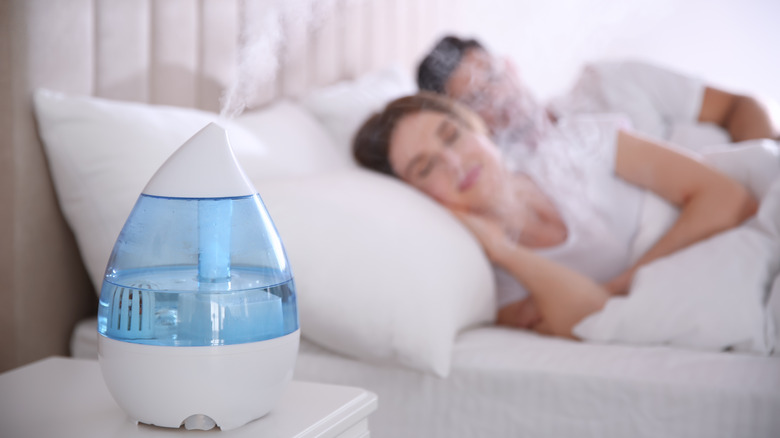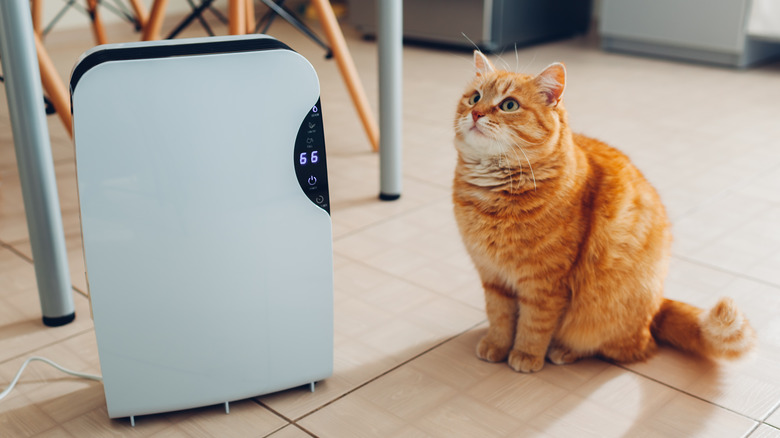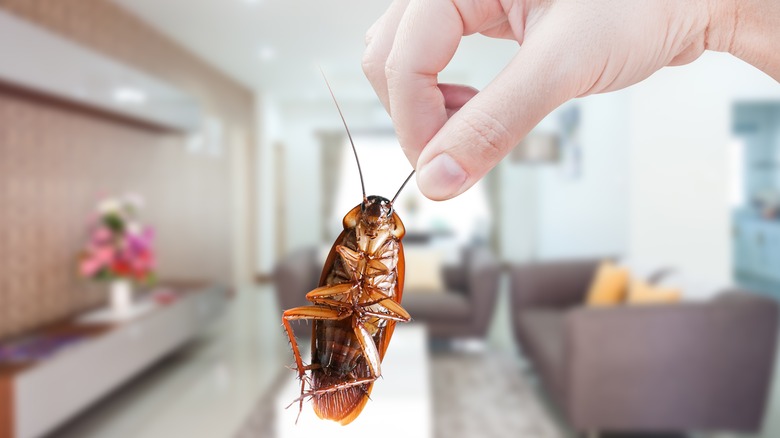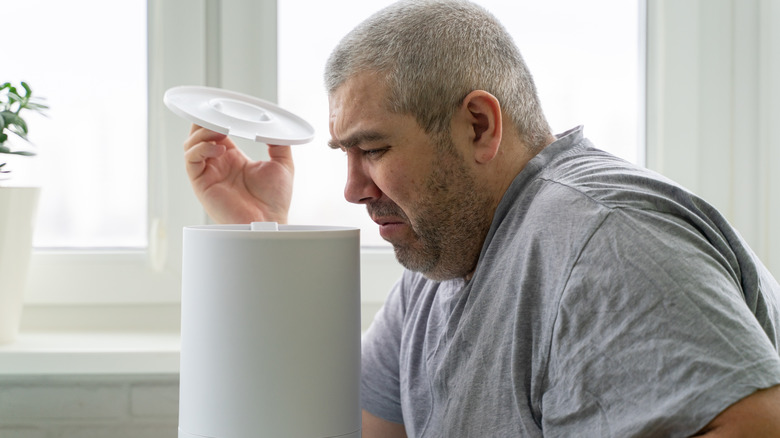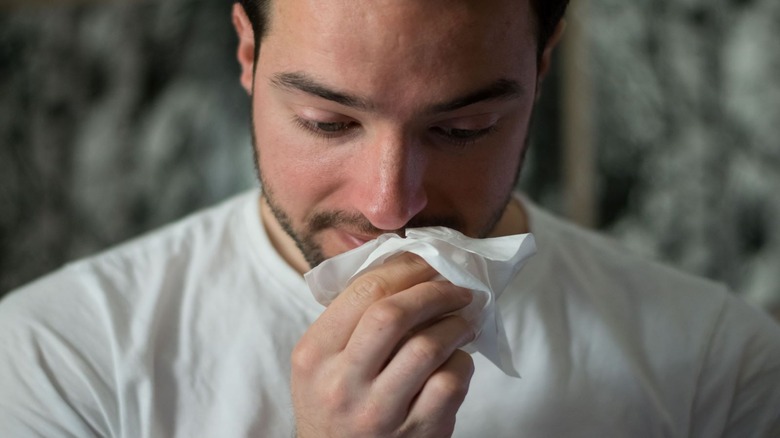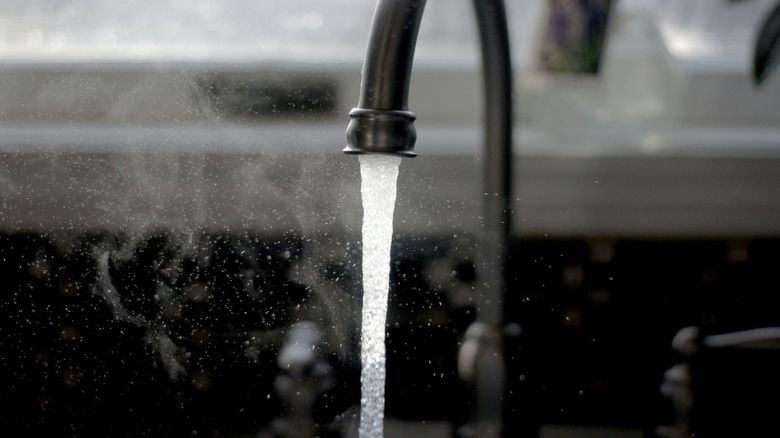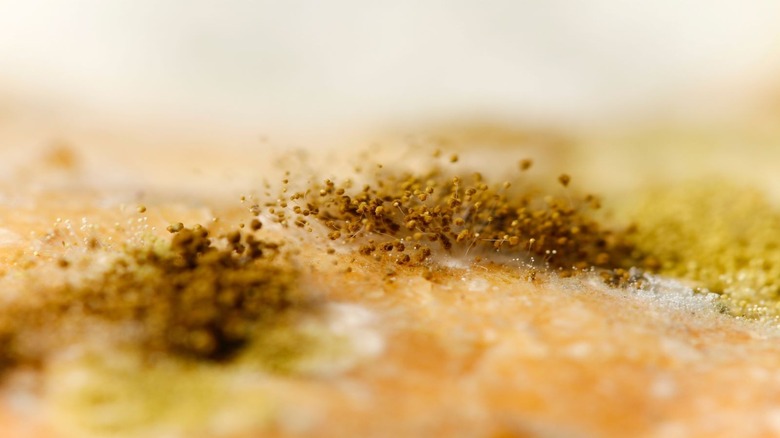The Hidden Downsides To Humidifiers
When winter's cold sends a shiver through our bones, it's hard to resist cranking up the heat and taking the chill off. However, anyone whose been through this drill knows the consequences extend beyond high heating bills. Dry heat can lead to a myriad of health problems, including cracked skin, itchy and watery eyes and throat, nasal congestion, respiratory problems, and much more, according to Norelle Health. This part is where a humidifier steps in to save the day. A room humidifier is one of the most popular hacks to survive this arid and physically damaging indoor climate. Installing one of these into your home will help you stay happy and refreshed. There are at least 8 million sold in the United States each year (via Energy Star). Popular, yes, but safe? That depends.
A dirty or improperly used humidifier can introduce a whole host of health problems — some serious. It can also be the welcome mat for cockroaches, dust mites, and mold, all of which repay your hospitality with their own brand of health problems. You'll want to follow the manufacturer's directions carefully, even if you have to add chores like regularly changing humidifier water. You're doing your utmost to see that your humidifier safely contributes moisture to the home without any negative consequences. Here are the hidden downsides to humidifiers everyone should know about before purchasing one for their home.
Mold or bacteria can lurk inside
Hectic schedules often put chores on the back burner, but the care and cleaning of your room humidifier have no place there. If you're too busy to clean a humidifier, many experts advise leaving it in the box — skipping it altogether. It doesn't take long before mold and bacteria set up house in a humidifier — just a matter of days. While a humidifier may alleviate cracked lips, a bloody nose, and dry eyes from heat, a mold-contaminated unit can introduce serious, sometimes lingering illnesses. According to the Mayo Clinic, mold and bacteria grow in moist and unclean conditions — like your neglected humidifier. Mold can lead to respiratory problems, flu-like symptoms in healthy people, and flareups in those with asthma and allergies.
To prevent mold from entering your humidifier and the air you breathe, get into the routine of emptying the tank after unplugging and drying it. Then give it a thorough cleaning about every three days or more. This tip should include eliminating mineral deposits or film with something like 3 percent hydrogen peroxide, which is available at most pharmacies. Clean the unit thoroughly and rinse all cleaning products before the next use. Otherwise, the cleaning chemicals will become airborne and possibly toxic consequences for you, your family, and your pets.
Excessive humidity can lead to mold growth
Even clean humidifiers can contribute to mold, a potentially deadly fungus if allowed to dispense high humidity levels into a home. Like Goldilocks, you don't want too much or too little. In excessive quantities, humidity can lead to all types of woes, including respiratory issues, flu-like symptoms, and increased asthma and allergies.
According to The Ozone Hole, when humidity levels top 55 percent, the conditions are ideal for mold to grow. Where there's high humidity, mold won't be far behind. While it's not uncommon for humidifier use to create mold-friendly conditions, especially on walls, windowsills, and other porous surfaces, one little tool can help end the invasion. The tool is a digital hygrometer — some humidifiers even come equipped with it — and it can help keep your relative humidity within the recommended zone of 30 to 50 percent. Hygrometers can measure the amount of moisture in the air with sensors. While it's not complicated, especially with the digital models, measuring for moisture is not the first thing that comes to mind when someone buys a humidifier.
Dust mites and cockroaches love humidity
Mold is one thing, but the yuck factor pumps up when the invasion involves moving creatures. Too much humidity — from a humidifier or other source — can bring this kind of trouble into a house. According to the American Lung Association, cockroach allergens can be stirred up into the air when cleaning or vacuuming the dust that has settled. These allergens can trigger asthma and allergies, and studies show they may even be responsible for asthma in preschoolers. Can't wait to plop your head on the pillow after a long hard day? Cockroach allergens can be inhaled from bedding, zapping the typically curative powers of a night of peaceful slumber.
Warm, humid environments are also perfect for dust mites. These tiny bugs are related to spiders, live in dust, and feed upon dead skin cells (via the Mayo Clinic). Although microscopic, dust mites can create big allergy woes and gravitate to that most tranquil of places, our bedroom. A dust mite allergy can go beyond the occasional runny nose, watery eyes, and sneezing to a severe asthma attack that requires emergency care. All this certainly gives humidifier care warnings a new priority.
White scale buildup can emit dust particles and enter lungs
How do you know if your humidifier is harboring bacteria or fungi? According to the U.S. Consumer Product Safety Commission (CPSC), a telltale sign is a crust-like deposit or scale seen within the tank and on water-submerged parts. The minerals within the scale can build up outside of the water, becoming like nirvana for fungi and bacteria. These minerals are also to blame for releasing fine white dust in the humidifier mist. Look out lungs because this dust may contain tiny particles small enough to invade and cause potentially harmful side effects.
There's still plenty to learn about minerals, white dust, and their impact on the lungs, so it's best to exercise caution. Besides regular cleaning, you can avoid white scales with distilled or demineralized water — but never tap water! Tap water is rich in minerals, which can only acerbate a scale buildup issue and release some undesirable chemicals into the air and lungs. Keeping your home's humidity at the golden 30 to 50 percent and checking levels with a hygrometer is another way to banish scale before it welcomes friends like fungi and bacteria.
Disinfectants can be toxic
Microbe buildup in a humidifier is terrible, but tackling it with a disinfectant additive can be much worse. According to Yale School of Public Health, an outbreak of lung disease in Korea exemplifies why disinfectants are risky to use in your humidifier. Dr. Gary Ginsberg, a public health toxicologist from Connecticut, recommends avoiding humidifier disinfectants, marketed as bacteria-fighting agents. The problem is that chemical disinfectants can become airborne and irritate the lungs, such as in the tragic event in Korea. Although the product involved in the Korean incident is unavailable in the United States, humidifier disinfectants and additives are risky. Nothing can beat changing the humidifier water daily and cleaning the tank and chambers every two or three days with simple soap and water. As for the humidifier parts, wiping them with a mild disinfectant like vinegar can safely complete the task. Whatever you do, rinse thoroughly before reassembling and running the humidifier. There is no need for something harsh like bleach.
Of course, caution also should be exercised with essential oils. There are diffusers especially made for dispersing oils into the air for health benefits. If your humidifier does not have a diffuser to allow safe use of essential oils, you could be causing harm, not health. Read, read, and read your manufacturer's care manual and the essential oil label to guide your actions.
Steam humidifiers can cause serious burns
The plus side of steam humidifiers is that they are not known for sending substantial levels of minerals into the air, per the U.S. Environmental Protection Agency (EPA). The negative side is that steam humidifiers get hot enough to cause burns. They are particularly unsafe for children, who can be inquisitive, but lack caution and may get too close to warm mist or knock over the machine.
Steam vaporizers use electrodes or an electrical heating element to heat water and make steam. It does the job of keeping our eyes and nose moist during winter, making it easier to breathe, especially for those with respiratory woes. Rather than dispense hot air, warm mist humidifiers are a type of steam vaporizer humidifier that cool the water before sending it airborne. Steam vaporizer humidifiers should stay out of reach of children due to the burn danger from steam and boiling water. Parents should use caution when determining where to place a steam humidifier in a room. They might want to weigh the pros and cons, as well as the activity level and maturity of the child. Upon examination, they may choose a cool mist humidifier to avoid burns.
Flu-like symptoms and respiratory problems can arise
Just how bad is a dirty humidifier for your health? Well, the machine you purchased to make breathing easy in the winter when heating systems run full blast can trigger lung problems — even infection — and bring on symptoms resembling the flu. The U.S. Consumer Product Safety Commission (CPSC) confirms that dirty humidifiers can cause all these ailments in the healthy population. An unclean machine can exacerbate allergies or asthma. It poses the added threat of intensifying their symptoms.
One example of a lung issue that can arise from humidifier use came up in a case study (via ScienceDirect). The problem was humidifier lung, a rare type of lung infection known as hypersensitivity pneumonitis. There was an example of a 46-year-old man who exhibited a fever, cough, and low oxygen levels when he arrived at the hospital. He had used an ultrasonic humidifier for two months before the onset of symptoms. The medical investigation revealed that his humidifier water contained multiple types of bacteria, fungi, and a large amount of endotoxin (a toxin that lurks inside a bacterial cell). This man got better without medication simply by getting rid of his humidifier.
Contaminated humidifiers may contribute to lung disease in children
It is particularly heartbreaking when children contract diseases like lung conditions, but such can be the case with chronic exposure to humidifier contamination like fungi, per Children's Hospital Colorado. Of course, humidifiers are not the only environmental factor that may play a role in causing pediatric interstitial lung disease. The causes can be as unique as the child and may be inherited. However, humidifiers can be part of the problem. Fortunately rare, children's interstitial and diffuse lung disease is a group of lung diseases that can cause problems with the airways, air sacs, or space between the air sacs.
Interstitial lung disease is associated with respiratory distress, recurring pneumonia and bronchiolitis, fast breathing, shortness of breath during exercise in older children or eating in infants, changes in skin color, and poor growth. With a stethoscope, a doctor may determine crackling sounds in the chest or the child may exhibit coughing or wheezing. Another symptom can be the clubbing of fingernails, which present as unusually wide and round. Again, fungi in a humidifier is just one possible contributor, but one that is entirely avoidable.
Cool mist models are prone to disperse microorganisms
While there are several types of humidifiers, some of the most popular models are those the U.S. Environmental Protection Agency (EPA) has associated with the release of microorganisms and minerals into the air. Those models are the ultrasonic or impeller humidifiers, both of which create a cool mist, one through ultrasonic sound vibrations, the other through a high-speed rotating disc. They increase humidity levels while dispersing a cooling mist into the air, making them ideal for the summer months. Whatever goes into the humidifier tank, especially the cool-mist variety, is bound to enter the air sooner or later. Of course, consumers can reduce the risk with fresh water and regular cleaning, but EPA these precautions cannot eliminate unwanted airborne materials entirely.
Just what is a microorganism? As the name suggests, they are microscopic in size and can include bacteria, mold, fungi, and algae. The common offenders in a humidifier water tank are likely to be mold and bacteria. Breathing such mist day after day can trigger lung inflammation. While that sounds scary, the federal government has not equated microorganisms and other minerals dispersed by a humidifier with a serious health risk. Those prone to problems with airborne materials tend to be children, senior citizens, and those with respiratory problems, be it lung disease or allergies. The key is to properly care for your humidifier, which will cause minerals and microorganisms to stay to a minimum.
Humidifiers require distilled water
Okay, this may not seem like a big one, but it can be a problem if you're accustomed to using distilled water in your humidifier and run out in the middle of the night. Adding a humidifier to your life will take some planning. The benefits are worth it for many, including no more heat headaches or dried-out nasal passages. Some humidifiers go through half a gallon of water at night at a low setting, so make your food shopping list accordingly. If you look forward to the easy breathing a humidifier can promote, you won't want to be suddenly without. But why can't we turn on the tap, fill the humidifier tank, and get back to sleep?
According to the Centers for Disease Control and Prevention (CDC), waterborne germs can live in pipes leading to your faucet and group together in a biofilm. Think of a biofilm as a colony that often contains a mix of bacteria, fungi, and amoeba. Well-equipped to survive treatments like chlorine, the colony releases a slimy, glue-like material that lets it thrive. Waterpipes are a favorite hangout. If you turn on the tap and fill up your humidifier tank, you will get a questionable mist. However, the mist is less likely to be a problem with faucets you regularly use. The other reason to use distilled water is that it has a lower mineral count, which reduces the chance of scale buildup dispersing materials into the air. Distillation is one of the best ways of removing minerals, but even this water contains some.
Humidifier filters can also harbor mold
Contaminated tank water is not the only way a humidifier can be a source of mold. Humidifiers with filters, like the invisible moisture variety operating with a wicking filter, must be kept clean, or your health may pay for it. According to Honeywell, an unkept filter can breed mold and bacteria. In this case, it may give off an odor alerting you that there is a problem, and the filter may no longer be able to work as intended. The filter's job is to remove minerals and impurities before they evaporate into the air. A filter plays a big part in eliminating white dust, which stems from minerals.
While it may seem economical to soak the filter to loosen scale, humidifiers still require a new filter every 30 to 60 days — and much sooner if there is a foul odor or signs of mold. Keep your humidifier clean by doing a quick daily rinse and refilling it with water. As discussed earlier, people with allergies or asthma can react strongly to household mold exposure. If you have a humidifier with a filter, following the manufacturer's instructions is an essential step to keep mold and the doctor away. A room humidifier can make the winter heating system bearable, especially for those with respiratory issues. Taking the proper care will ensure the humidifier is a step toward, not away from, good health in your home.
